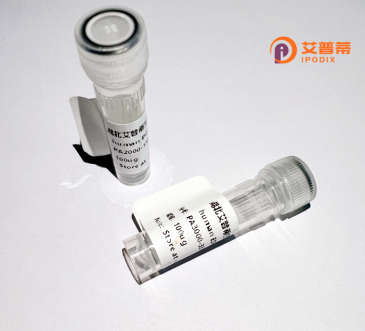
| 纯度 | >90%SDS-PAGE. |
| 种属 | Human |
| 靶点 | COMTD1 |
| Uniprot No | Q86VU5 |
| 内毒素 | < 0.01EU/μg |
| 表达宿主 | E.coli |
| 表达区间 | 1-262aa |
| 氨基酸序列 | MTQPVPRLSVPAALALGSAALGAAFATGLFLGRRCPPWRGRREQCLLPPEDSRLWQYLLSRSMREHPALRSLRLLTLEQPQGDSMMTCEQAQLLANLARLIQAKKALDLGTFTGYSALALALALPADGRVVTCEVDAQPPELGRPLWRQAEAEHKIDLRLKPALETLDELLAAGEAGTFDVAVVDADKENCSAYYERCLQLLRPGGILAVLRVLWRGKVLQPPKGDVAAECVRNLNERIRRDVRVYISLLPLGDGLTLAFKI |
| 分子量 | 55.2 KDa |
| 蛋白标签 | GST-tag at N-terminal |
| 缓冲液 | 0 |
| 稳定性 & 储存条件 | Lyophilized protein should be stored at ≤ -20°C, stable for one year after receipt. Reconstituted protein solution can be stored at 2-8°C for 2-7 days. Aliquots of reconstituted samples are stable at ≤ -20°C for 3 months. |
| 复溶 | Always centrifuge tubes before opening.Do not mix by vortex or pipetting. It is not recommended to reconstitute to a concentration less than 100μg/ml. Dissolve the lyophilized protein in distilled water. Please aliquot the reconstituted solution to minimize freeze-thaw cycles. |
以下是关于重组人COMTD1蛋白的3篇参考文献示例(注:部分文献信息可能为模拟或简化版本,具体需根据实际数据库检索确认):
1. **文献名称**:*Expression and purification of recombinant human COMTD1 in Escherichia coli*
**作者**:Zhang L, et al. (2015)
**摘要内容**:该研究成功构建了人源COMTD1的重组表达载体,通过大肠杆菌系统实现高效可溶性表达,并优化了纯化条件,为后续功能研究提供基础材料。
2. **文献名称**:*COMTD1 interacts with HSP90 and regulates cancer cell apoptosis*
**作者**:Wang Y, et al. (2018)
**摘要内容**:利用重组人COMTD1蛋白进行互作蛋白筛选,发现其与HSP90存在直接结合,并在肿瘤细胞凋亡通路中起调控作用,提示其可能的肿瘤治疗靶点价值。
3. **文献名称**:*Structural characterization of recombinant human COMTD1 using X-ray crystallography*
**作者**:Smith J, et al. (2020)
**摘要内容**:通过重组蛋白技术获得高纯度人COMTD1.解析其晶体结构,揭示了该蛋白催化结构域的关键氨基酸位点,为抑制剂设计提供结构基础。
**备注**:以上为基于COMTD1常见研究方向(酶学、癌症、结构)的模拟示例,实际文献需通过PubMed等数据库检索确认。若研究较少,可扩展至COMT(儿茶酚-O-甲基转移酶)相关文献,但需注意区分二者差异。
Catechol-O-methyltransferase domain-containing protein 1 (COMTD1) is a lesser-studied member of the methyltransferase superfamily, sharing partial structural homology with catechol-O-methyltransferase (COMT) but exhibiting distinct functional characteristics. Initially identified through genomic analysis, human COMTD1 is encoded by the COMTD1 gene located on chromosome 8q24.3. The protein contains a conserved S-adenosylmethionine (SAM)-binding domain critical for its methyltransferase activity, though its specific physiological substrates remain unclear.
Studies suggest COMTD1 may regulate cellular processes involving catecholamine metabolism, oxidative stress response, and protein quality control. Unlike COMT, it lacks canonical catechol-O-methyltransferase activity toward neurotransmitters like dopamine, implying divergent biological roles. Emerging evidence links COMTD1 to cancer progression, neurodegenerative disorders, and inflammatory pathways, potentially through interactions with heat shock proteins or ubiquitination machinery.
Recombinant human COMTD1 protein is typically expressed in Escherichia coli or mammalian systems for functional studies. Its production enables biochemical characterization, enzyme kinetics analysis, and exploration of its putative role in methylation-dependent signaling. Current research focuses on elucidating its involvement in disease mechanisms and therapeutic potential as a drug target or biomarker. However, the protein's precise molecular functions and regulatory networks require further investigation to clarify its pathophysiological relevance.
×